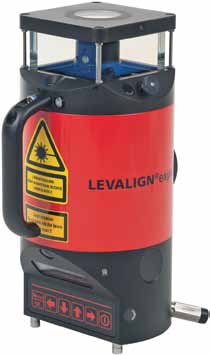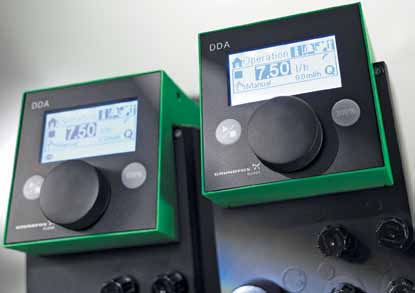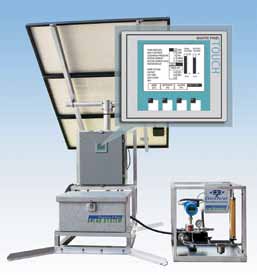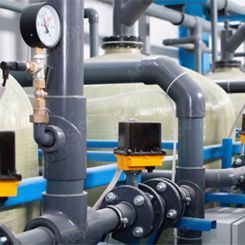The third annual Product Innovation of the Year award was hotly contested again this year. The contest examined products entered into the marketplace between September 1, 2010 and August 31, 2011.
Pumps & Systems' Editorial Advisory Board and editors selected the winners.
This year's winner is LUDECA, Inc. LUDECA's LEVALIGN EXPERT is a tool that allows end users to determine the flatness/levelness of bases and frames. It helps avoid strain that can occur when a machine is bolted to a distorted surface.
With a level surface, problems such as vibration and misalignment can be avoided, saving money on maintenance and repair and avoiding downtime.
With a second place finish in a tight race, Grundfos Pumps' SMART Digital Dosing Pump technology is intended for a wide array of water-treatment applications: drinking, process, ground, surface, recreational, recycle and reuse. It keeps processes running precisely, reliably and cost-effectively.
CheckPoint Pumps and Systems' Intelliject™ Solar System took third place this year. It is a completely self-sustaining solar powered chemical injection package, so it needs no outside power source besides the sun.
Two other products—the Super Critical CO2 Energy Recovery System from Concepts NREC and PROACTOnDemand from Reliability Center, Inc., received honorable mentions
Congratulations to our winner, finalists and honorable mentions!
2011 Product Innovation of the Year Winner: LUDECA, Inc.
LEVALIGN EXPERT

Innovation
Introduced in July 2011, the LEVALIGN EXPERT allows end users to measure the flatness/levelness of the bases and frames that hold pumping equipment. Proper machine installation is critical to maximize reliability and minimize life cycle costs. One of the biggest issues in the machinery installation process is that many machines are installed under strain because they are bolted to distorted bases or frames. Checking a machine base for flatness before installation can save time and trouble dealing with vibration, misalignment and soft foot problems that are created by a distorted or non-flat surfaces.
The LEVALIGN EXPERT provides an accurate and easy-to-use method for the measurement of flatness and straightness of machine bases and foundations, split machine casings, as well as flatness and parallelism of circular, rectangular and odd-shaped flanges. The system consists of a self-leveling motorized rotating laser and a sensor that interfaces wirelessly with the ROTALIGN ULTRA computer.
The surface profile of the measured component is displayed with full-color, 3D graphics for a more intuitive evaluation of the results. Features, such as InfiniSplice, allow merging measurement files. This gives the operator the freedom to reposition the rotating laser to another location during measurement to overcome obstructions to line-of-sight and measure complex-shaped surfaces.
Surface flatness measurement using this tool is simple and straightforward—only a single operator is needed to measure large or complex vertical and horizontal surfaces. The tool allows for flatness measurements in situations that were previously considered impossible to measure due to line-of-sight obstructions.
Statistical Data
Some pump and processing measurement applications include:
- Flatness and levelness of baseplates and machine foundations
- Pump split case and flange flatness
- Rail elevation and parallelism
- Circular, rectangular and complex surface profiles
Other data was gathered by an field service engineer. “We recently completed a flatness measurement of the exposed portions of a gearbox foundation with the gearbox installed,” says Daus Studenberg, application and field service engineer, LUDECA, INC. “We were able to move the LEVALIGN EXPERT laser during measurement to allow measurement around the gearbox. The self-leveling automatic rotating laser in combination with the 2.75-inch measurement range allowed us to take 47 points around the gearbox in less than 10 minutes from start to finish.”
2011 Product Innovation of the Year 2nd Place: Grundfos Pumps
SMART Digital Dosing Pump

Innovation
The SMART Digital Dosing Pump technology, introduced to the market at the end of August 2010, is intended for a wide array of water-treatment applications: drinking, process, ground, surface, recreational, recycle and reuse. Appropriate processes are equally wide-ranging: chemical dosing, disinfection, pH-adjustment, cooling and boiler, cleaning-in-place, biocide injection, coagulation, precipitation/flocculation, filtration and reverse osmosis.
The SMART Digital dosing pumps keep these processes running precisely, reliably and cost-effectively. With the latest drive technology and state-of-the-art electronics, the user-friendly operation and intelligent flow control save chemicals with high dosing accuracy. The pumps also include an intelligent decision-making microprocessor that can compare the user-set capacity against real-time signals and adapt the injection rate. The pump has been used at the Beaufort – Jasper Water and Sewer Authority (BJWSA), which is a non-profit authority established by S.C. to provide drinking water and treat wastewater in Beaufort and Jasper counties.
Statistical Data
This entry-level range economically offers the benefits of digital dosing to smaller water treatment, recycling and reuse applications. The two models in the DDE series span a range that formerly required coverage by 12 pumps or more.
2011 Product Innovation of the Year 3rd Place: CheckPoint Pumps and Systems
Intelliject Solar System

Innovation
The Intelliject™ Solar System is used for automated chemical injection, an integral part of the oil and gas production process, in remote areas that do not have access to a hard power source. Introduced to the marketplace in November 2010, it is a completely self-sustaining, solar-powered chemical injection package, so it needs no outside power source besides the sun. It has an efficient pump, closed loop automation, real-time flow feedback and power management features that override human error to keep the unit running non-stop, even through consecutive days without sunlight.
Simple set-and-forget control and monitoring can be performed locally through the LCD touch screen, human-machine interface (HMI) or remotely from a SCADA system. This all adds up to being an accurate and dependable dosing system, providing significant cost savings over time in several ways.
Statistical Data
Even the most robust competitive product comparable to this unit operates based on calculated data, not actual flow feedback, and does not include true power management. First, changes in pressure in the process line, which are common, can considerably alter the actual injection rate into the line. Without flow feedback or at least pressure feedback and associated table data regarding flow, end users cannot accurately determine the injection rate. This could lead to differences of up to 50 percent, correlating to an equal amount of waste of expensive chemicals. Second, without hardware to monitor battery voltage, incoming panel amperage and current load, over usage of the pump cannot be prevented, which depletes the batteries and fails the system. These failures regularly cause costly well shut-ins.
Tim Morrison from Monocor Energy Systems, LLC, says, “The remote solar chemical injection unit has been…operating perfectly. [It] is very accurate and has never lost prime. Remotely adjusting the chemical injection rate from a laptop saves time and money.”
In this instance, the Intelliject Solar System replaced an existing pneumatic setup. It was estimated that there would be a recurring chemical savings of 20 percent. Based on a chemical cost of $12.50 per gallon and an injection rate of 60 gallons per day, the customer will save $54,000 in chemicals per year.
2011 Product Innovation of the Year Honorable Mention: Concepts NREC
Super Critical CO2 Energy Recovery System
Innovation
The Super Critical CO2 Energy Recovery System was introduced in June 2011 and enables energy recovery from a gas turbine engine that is used to provide propulsion power for a U.S. Navy vessel. The system uses carbon dioxide (CO2) as the working fluid in the power cycles (technically known as Supercritical Brayton Cycle) to recover the otherwise wasted energy from the exhaust gases of the engine. The system's heat recovery exchangers are specially designed to fit within the existing exhaust gas ducting and are designed to include thermoelectric generator devices to recover energy and directly transform that heat energy into electrical power. The system improves efficiency of the gas turbine by 13 percent or improves the power generation of the gas turbine by 22 percent over its mission duty cycle.
Statistical Data
The Phase 1 feasibility analysis revealed a power improvement over the MT-30 gas turbine engine of 20 percent, with only the baseline, simple S-CO2 waste heat recovery system, to as high as 27 percent when as many as four TEG systems are included in various places within the S-CO2 cycle.
2011 Product Innovation of the Year Honorable Mention: Reliability Center Inc.
PROACTOnDemand
Innovation
PROACTOnDemand was introduced in September 2011. The PROACT Root Cause Analysis (RCA) Subscription-Based Web Version delivers RCA economically, securely, efficiently and globally, 24 hours per day, seven days per week. This first-of-its-kind cloud computing service provides all the tools to collaborate, perform and deliver RCA.
PROACTOnDemand uses cloud computing that allows the purchasers to access their own personal, secured RCA program to work in. No IT personnel are required to work within the PROACT RCA environment, and no additional software has to be purchased and installed. It is accessed at any time via a web browser. RCA teams can collaborate and share investigation details globally to perform and deliver their RCA.
Statistical Data
Statistically, the time from purchase to installation of an enterprise edition of PROACTOnDemand has been reduced 99 percent over all. The new PROACTOnDemand platform improves the work flow process 100 percent over the enterprise edition allowing customers the superior quality and ease of use with only a web browser. The decrease of the IT department for any computer configuration for the user has been reduced 99 percent. Over all, PROACTOnDemand offers a 100 percent probability of concurrent use, performance and delivery of a completed RCA.
Pumps & Systems, December 2011

